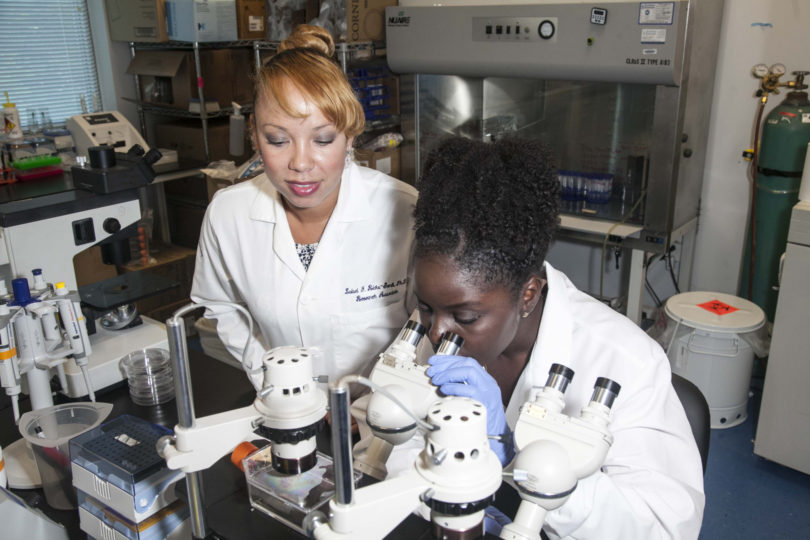How Increasing Minority Participation In Research Can Improve Medical Outcomes for Underserved Populations
In 1932, the United States government began recruiting poor, black men in Alabama. Hundreds of men, plied with promises of free meals, physicals and most importantly, medicine and treatment, were told they’d be treated for “bad blood” if they agreed to be tested.
But it was all a scam. The so-called study was really a secret experiment by the U.S. Public Health Service to study the progression of syphilis without treatment, and it went on for 40 years. Most men didn’t even know they had syphilis — a venereal disease that can turn deadly. Even after penicillin was discovered and used to treat syphilis, the men were never offered the antibiotic.
Despite the forced end to the program, the class-action lawsuit and the presidential apologies, the fall-out of the “Tuskegee Study of Untreated Syphilis in the Negro Male” remains to this day, leaving many minorities, especially black men, wary of doctors and medical institutions.
Hampton University’s Cancer Research Center (HUCRC) is hoping to play a part in changing that mindset. Led by director Dr. Luisel Ricks-Santi, the center wants to dispel the misconceptions that some minorities hold about medical research by letting them know just how important they are — and that their participation is needed in ongoing studies.
“People have a certain mistrust in the system because of what’s happened in the past,” says Ricks-Santi, who founded the Hampton, Va.-based research center in July of 2013. “But this has led to policies that protect study participants, including the requirement for consent and the ability to voluntarily withdraw from any study at any time.”
The Tuskegee experiments aren’t the only research that’s been called into question in the past. In the 1950s, birth-control pills were first human-tested on a large scale in a public-housing project in Puerto Rico, leading to the question of why that particular segment of the population was chosen. And then there’s Henrietta Lacks, the poor, black Roanoke woman whose cancer cells were taken without her consent in 1951 and turned out to be one of the most important tools in medical research — all while Lacks had no knowledge and received no compensation.
In 1974, Congress passed the National Research Act, which was aimed at preventing the exploitation of human subjects by researchers. But because of the past mistrust, while research has marched forward, there have been some left behind. The bottom line: There are segments of the population that might not be receiving the best medical help they can because there hasn’t been enough research. Because the more diversity there is in research, the more diversity there is in treatment options.
There are some diseases that for whatever reason, affect some segments of the population more than others. Prostate cancer is often more aggressive in ethnic minorities. Men of African descent seem to get tumors that are more likely to spread and more difficult to treat.
Black women who are diagnosed with breast cancer have a higher tendency to get the type that’s more difficult to treat, making them twice as likely to die as white women. As a scientist who studies how genetics can predispose one to cancer and also how genetics can be used to treat cancer, Ricks-Santi wants to know why.
Studying genes can better help identify those at risk, which in turn can help improve prevention and treatment for diseases depending on who is diagnosed. Then, treating the disease doesn’t have to be a one-size-fits-all approach but customized to fit a particular patient, Ricks-Santi says. “Chemotherapy has many side effects,” she says. “What if we can be more effective from the get-go?”
If at-risk populations aren’t participating in research or clinical trials, there’s never going to be clear answers, she says.
“It’s hard to make discoveries about a disease” for people who haven’t been included in research and clinical trials.
At the HUCRC, research is focused on studying cancer as a disease of the genome, which is an organism’s complete set of DNA, including all of its genes. The past decade alone has seen advances in the study of genetics, thanks to certain technologies in use in places like the CRC. And the more information researchers have to work with, the better they can study cancer development.
A lot of Ricks-Santi’s research is done on saliva samples, which she obtains from willing participants. From the saliva, she can look at genes and DNA and try and figure out what’s causing a disease. Researchers can examine how both genetics and environmental factors could be contributing to disease and look at how that information can be used to develop targeted therapies.
There are two ways the public can get involved in the HUCRC’s ongoing research studies. For the genetic study, participants can come in and provide a sample of saliva or blood. Although you get more DNA out of blood, “either is fine,” Ricks-Santi says.
The genetic study is one Ricks-Santi has been working on for some time, and she needs thousands of samples. “To do cancer disparity research, you have to have a population to compare to,” she explains.
The second way the public can get involved is through research focus groups. Minority males, who are among the most underserved populations in research, are simply asked to come in and answer questions. The answers will be used to help the HUCRC create messages about the importance of participants in research.
As part of a Minority Men’s Health Initiative, all minorities — including black, Asian and Hispanic — are being asked to take part over the next year.
“So we need people,” Ricks-Santi says. “The people who are going to benefit from the development of these tremendous tools and discoveries in research are people who participate. Those who will be cured are those who contribute. But we can only improve in certain populations if they participate.”
To find out more about the research studies and clinical trials available at HUCRC,
visit HUKnowsCancer.com or call 757-728-6034.




